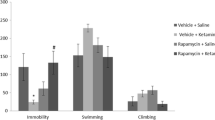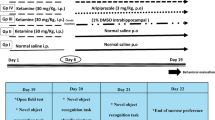Abstract
Schizophrenia is a severe chronic neuropsychiatric disorder, and it negatively affects individuals’ quality of life, but the pathogenesis of schizophrenia remains unclear. This study aimed to explore whether the administration of ketamine in rats causes changes in mTOR (mechanistic/mammalian target of rapamycin) expression in the hippocampus and prefrontal cortex. Ketamine was used to establish an animal model of schizophrenia. Rats were randomly divided into four groups: control group (normal saline), low-dose group (15 mg/kg ketamine), middle-dose group (30 mg/kg ketamine), and high-dose group (60 mg/kg ketamine). The rats were intraperitoneally injected with ketamine or normal saline twice a day (9 AM and 9 PM) for 7 consecutive days. Immunohistochemistry was used to detect mTOR protein expression in the hippocampus and prefrontal cortex from rats at 13 h after the last treatment. Using immunohistochemistry, the expression of the mTOR protein was localized exclusively in the CA3 region of the hippocampus and in the Cg1 region of the prefrontal cortexes. Ketamine at 60 mg/kg decreased the expression of mTOR protein in the brain of rats. Ketamine successfully established a rat model of schizophrenia. This study helps elucidate the mechanisms of ketamine-induced schizophrenia and provides novel insights for drug discovery and development.




Similar content being viewed by others
References
Abi-Saab W, D’souza D, Moghaddam B, Krystal J (1998) The NMDA antagonist model for schizophrenia: promise and pitfalls. Pharmacopsychiatry 31(S 2):104–109
Arai S, Takuma K, Mizoguchi H, Ibi D, Nagai T, Takahashi K et al (2008) Involvement of pallidotegmental neurons in methamphetamine- and MK-801-induced impairment of prepulse inhibition of the acoustic startle reflex in mice: reversal by GABAB receptor agonist baclofen. Neuropsychopharmacology. 33(13):3164–3175
Atkins AL, Helms ML, O’Toole LA, Belknap JK (2001) Stereotypic behaviors in mice selectively bred for high and low methamphetamine-induced stereotypic chewing. Psychopharmacology 157(1):96–104
Berman RM, Cappiello A, Anand A, Oren DA, Heninger GR, Charney DS, Krystal JH (2000) Antidepressant effects of ketamine in depressed patients. Biol Psychiatry 47(4):351–354
Bonhomme V, Vanhaudenhuyse A, Demertzi A, Bruno MA, Jaquet O, Bahri MA, Plenevaux A, Boly M, Boveroux P, Soddu A, Brichant JF, Maquet P, Laureys S (2016) Resting-state network-specific breakdown of functional connectivity during ketamine alteration of consciousness in volunteers. Anesthesiology. 125(5):873–888
Cheung HM, Yew DTW (2019) Effects of perinatal exposure to ketamine on the developing brain. Front Neurosci 13:138
Favretto D, Vogliardi S, Tucci M, Simoncello I, El Mazloum R, Snenghi R (2016) Occupational exposure to ketamine detected by hair analysis: a retrospective and prospective toxicological study. Forensic Sci Int 265:193–199
Focking M, Doyle B, Munawar N, Dillon ET, Cotter D, Cagney G (2019) Epigenetic factors in schizophrenia: mechanisms and experimental approaches. Mol Neuropsychiatry 5(1):6–12
Forget P, Cata J (2017) Stable anesthesia with alternative to opioids: are ketamine and magnesium helpful in stabilizing hemodynamics during surgery? A systematic review and meta-analyses of randomized controlled trials. Best Pract Res Clin Anaesthesiol 31(4):523–531
Gururajan A, van den Buuse M (2014) Is the mTOR-signalling cascade disrupted in schizophrenia? J Neurochem 129(3):377–387
Haaf M, Leicht G, Curic S, Mulert C (2018) Glutamatergic deficits in schizophrenia - biomarkers and pharmacological interventions within the ketamine model. Curr Pharm Biotechnol 19(4):293–307
He Y, Zou Q, Li B, Chen H, Du X, Weng S et al (2016) Ketamine inhibits human sperm function by Ca(2+)-related mechanism. Biochem Biophys Res Commun 478(1):501–506
Huang S-H, Wu W-R, Lee L-M, Huang P-R, Chen J-C (2018) mTOR signaling in the nucleus accumbens mediates behavioral sensitization to methamphetamine. Prog Neuro-Psychopharmacol Biol Psychiatry 86:331–339
Hulsman N, Hollmann MW, Preckel B (2018) Newer propofol, ketamine, and etomidate derivatives and delivery systems relevant to anesthesia practice. Best Pract Res Clin Anaesthesiol 32(2):213–221
Javitt DC, Zukin SR, Heresco-Levy U, Umbricht D (2012) Has an angel shown the way? Etiological and therapeutic implications of the PCP/NMDA model of schizophrenia. Schizophr Bull 38(5):958–966
Jones CA, Watson DJ, Fone KC (2011) Animal models of schizophrenia. Br J Pharmacol 164(4):1162–1194
Krajcovic B, Fajnerova I, Horacek J, Kelemen E, Kubik S, Svoboda J, et al. (2019) Neural and neuronal discoordination in schizophrenia: from ensembles through networks to symptoms. Acta Physiol (Oxford):e13282
Krystal JH, D’Souza DC, Mathalon D, Perry E, Belger A, Hoffman R (2003) NMDA receptor antagonist effects, cortical glutamatergic function, and schizophrenia: toward a paradigm shift in medication development. Psychopharmacology. 169(3–4):215–233
Kuo HY, Liu FC (2019) Synaptic wiring of corticostriatal circuits in basal ganglia: insights into the pathogenesis of neuropsychiatric disorders. eNeuro;6(3)
Lahti AC, Weiler MA, Michaelidis BT, Parwani A, Tamminga CA (2001) Effects of ketamine in normal and schizophrenic volunteers. Neuropsychopharmacology. 25(4):455–467
Lee DY (2015) Roles of mTOR signaling in brain development. Exp Neurobiol 24(3):177–185
Leffa DD, Bristot BN, Damiani AP, Borges GD, Daumann F, Zambon GM, Fagundes GE, de Andrade VM (2016) Anesthetic ketamine-induced DNA damage in different cell types in vivo. Mol Neurobiol 53(8):5575–5581
Li L, Vlisides PE (2016) Ketamine: 50 years of modulating the mind. Front Hum Neurosci 10:612
Li N, Lee B, Liu RJ, Banasr M, Dwyer JM, Iwata M, Li XY, Aghajanian G, Duman RS (2010) mTOR-dependent synapse formation underlies the rapid antidepressant effects of NMDA antagonists. Science. 329(5994):959–964
Li H, Lu Q, Xiao E, Li Q, He Z, Mei X (2014) Methamphetamine enhances the development of schizophrenia in first-degree relatives of patients with schizophrenia. Can J Psychiatr 59(2):107–113
Lipton JO, Sahin M (2014) The neurology of mTOR. Neuron. 84(2):275–291
Liu Y, Lin D, Wu B, Zhou W (2016) Ketamine abuse potential and use disorder. Brain Res Bull 126(Pt 1):68–73
Liu FF, Zhao S, Liu P, Huo SP (2019) Influence of mTOR signaling pathway on ketamine-induced injuries in the hippocampal neurons of rats. Neurol Res 41(1):77–86
Loch AA (2019) Schizophrenia, not a psychotic disorder: Bleuler revisited. Front Psych 10:328
Ma J, Leung LS (2000) Relation between hippocampal gamma waves and behavioral disturbances induced by phencyclidine and methamphetamine. Behav Brain Res 111(1–2):1–11
Matuszko G, Curreli S, Kaushik R, Becker A, Dityatev A (2017) Extracellular matrix alterations in the ketamine model of schizophrenia. Neuroscience. 350:13–22
Oh S, Kingsley K (2018) Efficacy of ketamine in pediatric sedation dentistry: a systematic review. Compend Contin Educ Dent 39(5):e1–e4
Pham X, Song G, Lao S, Goff L, Zhu H, Valle D, Avramopoulos D (2016) The DPYSL2 gene connects mTOR and schizophrenia. Transl Psychiatry 6(11):e933
Ryskalin L, Limanaqi F, Frati A, Busceti CL, Fornai F (2018) mTOR-related brain dysfunctions in neuropsychiatric disorders. Int J Mol Sci;19(8)
Sassano-Higgins S, Baron D, Juarez G, Esmaili N, Gold M (2016) A review of ketamine abuse and diversion. Depress Anxiety 33(8):718–727
Saxton RA, Sabatini DM (2017) mTOR signaling in growth, metabolism, and disease. Cell. 168(6):960–976
Seeman MV (2019) Schizophrenia mortality: barriers to progress. Psychiatr Q
Skodlar B, Henriksen MG (2019) Toward a phenomenological psychotherapy for schizophrenia. Psychopathology.:1–9
Switon K, Kotulska K, Janusz-Kaminska A, Zmorzynska J, Jaworski J (2017) Molecular neurobiology of mTOR. Neuroscience. 341:112–153
Tandon R, Gaebel W, Barch DM, Bustillo J, Gur RE, Heckers S, Malaspina D, Owen MJ, Schultz S, Tsuang M, van Os J, Carpenter W (2013) Definition and description of schizophrenia in the DSM-5. Schizophr Res 150(1):3–10
Wearne TA, Cornish JL (2018) A comparison of methamphetamine-induced psychosis and schizophrenia: a review of positive, negative, and cognitive symptomatology. Front Psych 9:491
Weckmann K, Labermaier C, Asara JM, Muller MB, Turck CW (2014) Time-dependent metabolomic profiling of ketamine drug action reveals hippocampal pathway alterations and biomarker candidates. Transl Psychiatry 4:e481
Wesseling H, Rahmoune H, Tricklebank M, Guest PC, Bahn S (2015) A targeted multiplexed proteomic investigation identifies ketamine-induced changes in immune markers in rat serum and expression changes in protein kinases/phosphatases in rat brain. J Proteome Res 14(1):411–421
Winship IR, Dursun SM, Baker GB, Balista PA, Kandratavicius L, Maia-de-Oliveira JP, Hallak J, Howland JG (2019) An overview of animal models related to schizophrenia. Can J Psychiatr 64(1):5–17
Wu YQ, Liang T, Huang H, Zhu YZ, Zhao PP, Xu CM et al (2014) Ketamine inhibits proliferation of neural stem cell from neonatal rat hippocampus in vitro. Cell Physiol Biochem 34(5):1792–1801
Xu K, Krystal JH, Ning Y, He H, Wang D, Ke X et al (2015) Preliminary analysis of positive and negative syndrome scale in ketamine-associated psychosis in comparison with schizophrenia. J Psychiatr Res 61:64–72
Yoon SC, Seo MS, Kim SH, Jeon WJ, Ahn YM, Kang UG, Kim YS (2008) The effect of MK-801 on mTOR/p70S6K and translation-related proteins in rat frontal cortex. Neurosci Lett 434(1):23–28
Zarate CA Jr, Singh JB, Carlson PJ, Brutsche NE, Ameli R, Luckenbaugh DA et al (2006) A randomized trial of an N-methyl-D-aspartate antagonist in treatment-resistant major depression. Arch Gen Psychiatry 63(8):856–864
Zhuo C, Hou W, Li G, Mao F, Li S, Lin X, Jiang D, Xu Y, Tian H, Wang W, Cheng L (2019) The genomics of schizophrenia: shortcomings and solutions. Prog Neuro-Psychopharmacol Biol Psychiatry 93:71–76
Funding
This study was supported by the National Natural Sciences Foundation of China [Grant No. 81373239], the Yunnan Applied Basic Research/Kunming Medical University Union Project [Grant Nos. 2017FE467-(166) and 2018FE001-(011)], and the Kunming Medical University Innovation Group Project [Grant Nos. CXTD201604 and CXTD201803].
Author information
Authors and Affiliations
Contributions
R-F Xie and L-C Liao: study concept and design, analysis and interpretation of data, drafting of the manuscript, and obtained funding. R-F Xie and J-M Xie contributed equally to this work. R-F Xie, J-M Xie, Y Ye, X-Y Wang: the acquisition of samples or data, statistical analysis, review of the manuscript, and obtained funding. F Chen, L Yang, Y-Y Yan: statistical analysis, review of the manuscript, and material supports.
Corresponding author
Ethics declarations
All animal experiments were performed according to the Guide for the Care and Use of Laboratory Animals 8th Edition. The study was approved by the Ethics Committee of Kunming Medical University (Kunming, China).
Conflict of Interest
The authors declare that they have no conflict of interest.
Additional information
All authors declare that the submitted manuscript does not contain previously published data, and it is also not being under consideration for publication elsewhere.
Publisher’s Note
Springer Nature remains neutral with regard to jurisdictional claims in published maps and institutional affiliations.
Runfang Xie and Jiming Xie are joint first authors.
Rights and permissions
About this article
Cite this article
Xie, R., Xie, J., Ye, Y. et al. mTOR Expression in Hippocampus and Prefrontal Cortex Is Downregulated in a Rat Model of Schizophrenia Induced by Chronic Administration of Ketamine. J Mol Neurosci 70, 269–275 (2020). https://doi.org/10.1007/s12031-019-01476-9
Received:
Accepted:
Published:
Issue Date:
DOI: https://doi.org/10.1007/s12031-019-01476-9




